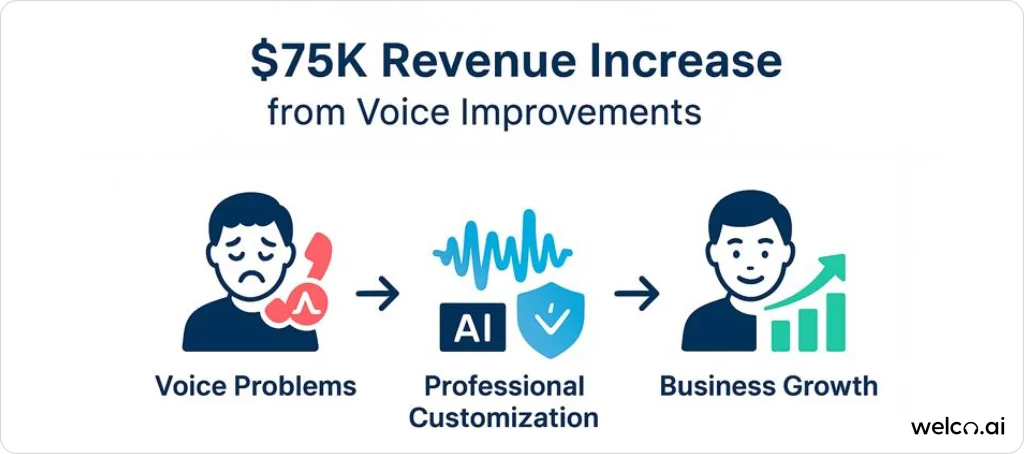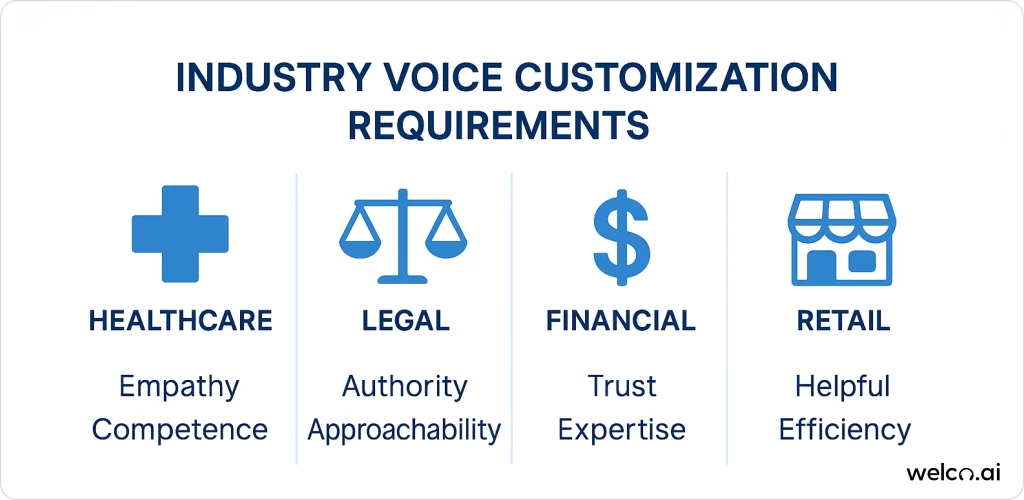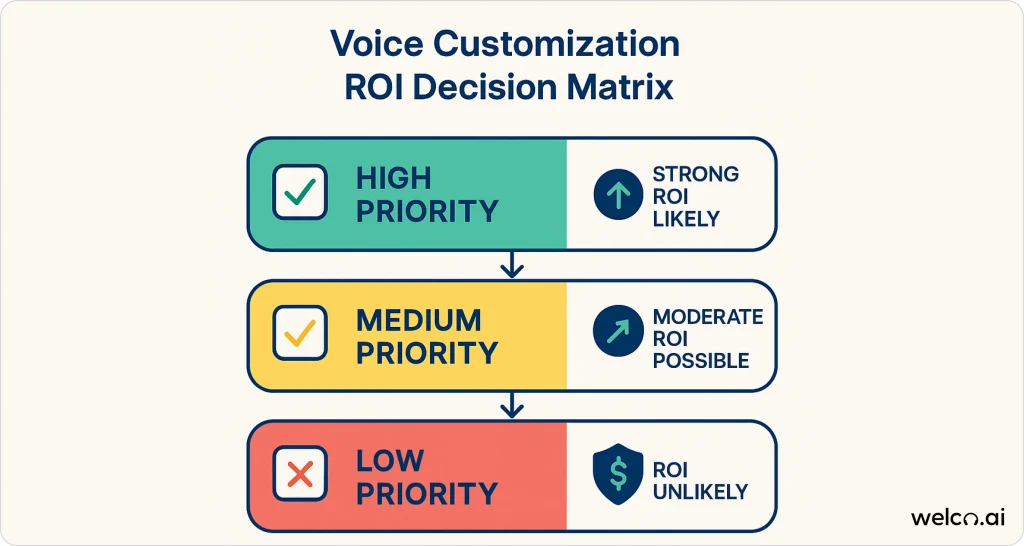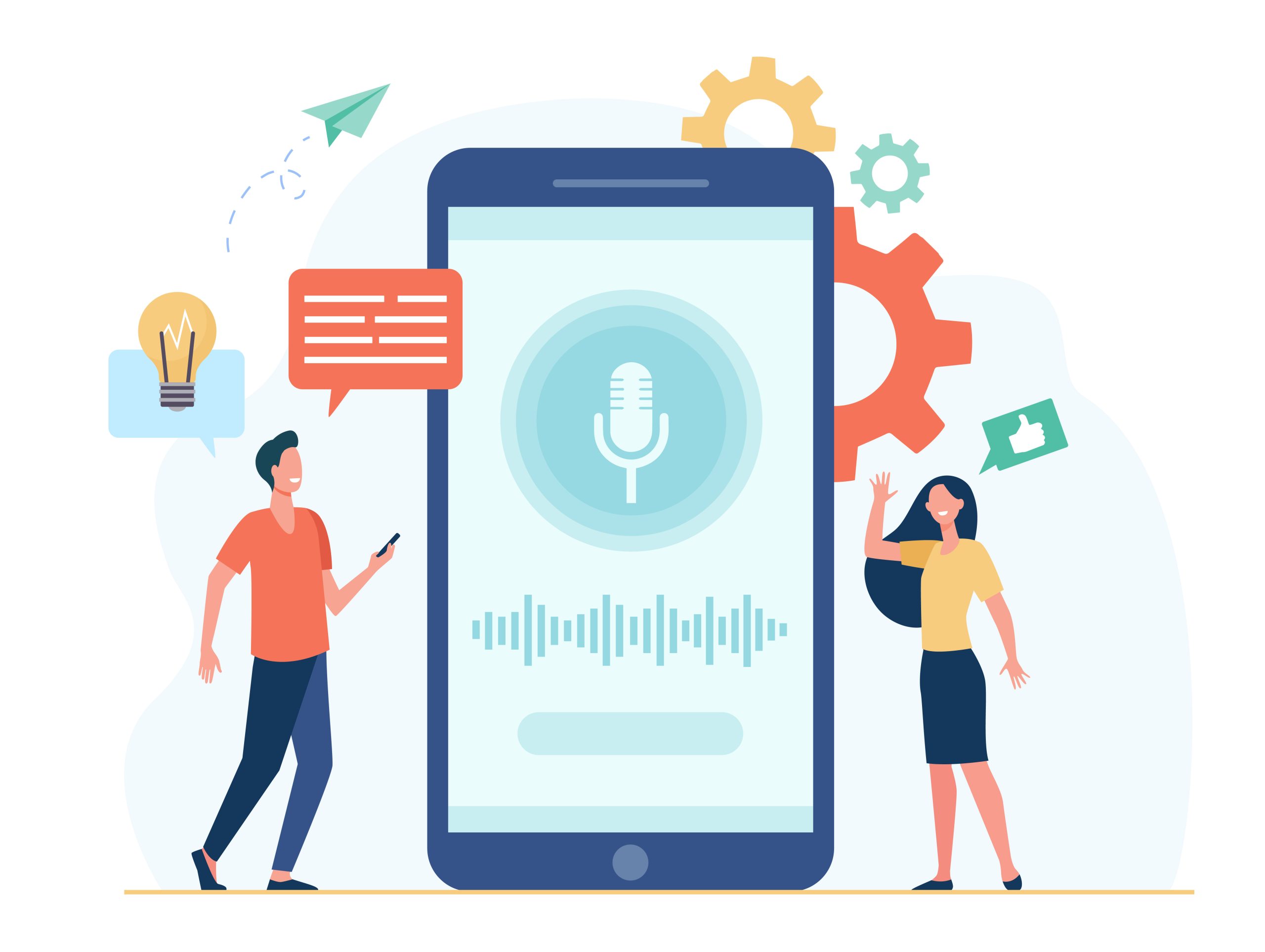Should You Invest in Voice Customization?
Your AI’s voice creates an instant impression about your entire business, often before prospects even explain why they’re calling. But AI voice customization isn’t right for everyone.
Voice customization makes sense when:
- Customers comment negatively on your current AI voice generator output
- Competitors sound noticeably more professional
- You’re losing prospects in the first 30 seconds of calls
- Your industry requires specific emotional responses (healthcare empathy, legal authority, financial trust)
- You have the budget and patience for 3-6 months of testing and refinement
Skip voice customization if:
- Your current professional AI voices generate no complaints
- You have deeper service or product quality issues
- Your industry sees minimal phone-based customer interaction
- You’re not prepared for ongoing optimization costs
- You expect voice alone to solve fundamental business problems
Red flags – Don’t invest in voice customization if:
- You need results within 30 days
- Your AI voice for business can’t handle basic customer questions
- You’re choosing the cheapest option available
- Customer complaints focus on service quality, not voice
Marcus, who runs an estate planning law firm in Beverly Hills, learned this lesson the hard way. Potential clients were hanging up on his AI voice assistant. The breaking point came when a prospective client told his partner the voice “sounded like someone working at a drive-through, not handling million-dollar estates.”
Marcus had invested heavily in sophisticated voice AI technology that worked flawlessly—except for the voice that undermined everything else. After three weeks of testing different AI brand voice options and another month of fine-tuning, he noticed prospects staying on calls longer. Within four months, those improved conversations had generated roughly $75,000 in new business, though it’s hard to isolate voice changes from other improvements they made during the same period.

Why Voice Psychology Actually Influences Behavior
Most business owners think AI voice branding means sounding “professional,” but there are specific psychological responses that different vocal qualities trigger. Understanding these patterns helps predict what will work for your specific audience.
The success of modern voice AI platform systems depends heavily on how natural language processing powers modern AI receptionists, enabling them to understand not just what customers say, but how they say it.
Voice Characteristics That Build Trust
Working with businesses across different industries, I’ve noticed certain vocal patterns consistently improve customer response through custom brand voice implementation:
Lower pitch generally conveys competence. Financial planning clients, especially those discussing significant assets, respond better to enterprise voice AI that sounds authoritative rather than enthusiastic. When someone’s talking about their life savings, they want to hear confidence, not perkiness.
Moderate speaking pace suggests expertise. Too slow sounds uncertain or condescending; too fast feels pushy or nervous. The sweet spot seems to be slightly faster than casual conversation but not rushed through AI voice optimization.
Regional accents can increase local connection, but it’s tricky. A Dallas law firm I worked with saw improved client response when their business voice generator had a subtle local accent, but when we tried something similar with a Miami practice, it backfired—clients found it unprofessional. Context matters enormously.
Warm undertones reduce anxiety in healthcare settings. This is especially critical when people are calling about medical procedures through healthcare AI voice systems. A voice that sounds genuinely caring can be the difference between someone booking an appointment and hanging up to call a competitor.
However, these patterns aren’t universal rules. What works depends entirely on your industry, customer demographics, and regional expectations. This is why testing with your actual customers is essential—assumptions about what sounds “professional” are often wrong.
The foundation for this sophisticated voice understanding comes from recent voice recognition technology breakthroughs in 2025, which have made natural conversation possible at unprecedented accuracy levels.
When Voice Choices Backfire
I’ve seen AI voice customization go wrong in instructive ways. A pediatric dental practice invested in what they thought was a “friendly” voice through their voice AI solutions, but it sounded artificially cheerful—like a cartoon character. Children found it more intimidating than their previous robotic-sounding system, and parents questioned whether the practice took dentistry seriously.
Meanwhile, their competitor across town uses AI voice technology that sounds like a warm elementary school teacher. It’s obviously artificial, but kids feel comfortable talking to it. The difference isn’t in the technology—it’s in understanding what “friendly” actually sounds like to your specific audience.
Real Examples (With All The Complications)
Medical Practice: Multiple Attempts to Get It Right
Dr. Sarah Kim’s cardiology practice started with professional AI voices that sounded clinical and cold. Patients complained it felt impersonal, especially problematic since people calling about heart procedures were already anxious.
Our first AI brand voice replacement was warmer but sounded too young—patients questioned the practice’s experience. The second attempt was better but inconsistent across different conversation types. Appointment scheduling sounded professional, but billing questions still sounded robotic.
It took four months and three voice synthesis AI iterations to develop something that worked: a voice that sounded like an experienced medical assistant—warm but professional, caring but competent. Patient callbacks about scheduling dropped from roughly 25 per week to about 15, and appointment completion rates improved noticeably, though we can’t be certain how much was voice versus other changes they made to their booking process.
This complexity demonstrates why machine learning call handling optimization becomes essential—the system needs to adapt to different conversation types and contexts automatically.
Law Firm: When “Professional” Isn’t Enough
Peterson & Associates wanted their legal AI voice to sound more professional than their previous system, which clients found unprofessional. We created what we thought was an authoritative AI voiceover, but it came across as intimidating—particularly problematic for family law clients dealing with emotional situations.
The solution required understanding that “professional” means different things in different legal contexts. Personal injury clients need reassurance; corporate clients need efficiency; family law clients need both competence and approachability. We ended up creating different brand voice AI variations for different practice areas, which added complexity but improved client response across the board.
Financial Services: The Challenge of Sounding Trustworthy
Harbor Wealth Management’s original AI voice generator was artificially cheerful, which felt inappropriate for serious financial discussions through their financial voice AI system. Our first replacement sounded competent but too formal—clients felt like they were calling a bank rather than a wealth management firm focused on personal relationships.
The eventual solution conveyed stability without sounding institutional through corporate voice AI, but it took six months to get right. Client referrals improved, and assets under management increased, though it’s impossible to separate voice impact from other relationship-building efforts they implemented simultaneously.
Retail Chain: When Voice Customization Fails Completely
A regional electronics retailer spent $18,000 on voice AI marketing hoping to reduce customer service calls by making their AI sound more helpful and knowledgeable. Despite multiple AI voice branding iterations over eight months, call volume to human agents actually increased.
The problem wasn’t voice—it was that their AI voice for business couldn’t answer basic product questions. Customers got frustrated with an AI that sounded competent but couldn’t deliver useful information. They eventually invested in better AI training and knowledge bases, which solved the real problem.
HVAC Company: When Industry Context Matters More Than Voice
A residential HVAC company spent $12,000 on AI voice customization, hoping to sound more professional than competitors. After six months of testing different commercial voice AI options, customer booking rates remained unchanged.
The reality: when someone’s air conditioning breaks in summer, they care about availability and response time, not how professional the AI voice assistant sounds. Customers calling for emergency repairs want quick answers about scheduling, not polished conversation. The company eventually focused on faster response times and better scheduling systems, which actually improved customer satisfaction.

Industry Considerations (More Complex Than They Appear)
Different industries create different emotional contexts, but the reality is more nuanced than simple categories suggest. Even within industries, specialties require different approaches.
Understanding conversational AI architecture for phone interactions helps explain why industry customization requires such sophisticated system design.
Healthcare: Not Just Empathy vs. Authority
Healthcare AI voice needs vary dramatically by specialty. Pediatricians need voices that sound safe to children but competent to parents. Oncologists need voices that convey expertise without sounding cold. Cosmetic surgeons need voices that sound professional without being judgmental.
Mental health practices face unique challenges—AI voice technology needs to sound caring without being intrusive, professional without being clinical. I’ve seen practices struggle for months to find this balance.
Legal Services: Context-Dependent Authority
A personal injury lawyer needs legal AI voice that sounds approachable to people in crisis. A corporate attorney needs efficiency and competence. A family law practice needs empathy without sounding weak. Estate planning requires gravitas without intimidation.
One criminal defense attorney tried professional AI voices that projected confidence but sounded aggressive—exactly wrong for clients already stressed about legal trouble. The replacement took months to perfect.
Financial Services: Trust Without Overselling
Financial voice AI firms face a particular challenge: sounding trustworthy without sounding sales-focused. High-net-worth clients have different expectations than middle-income retirement planners. Investment advisors need different vocal qualities than insurance agents.
A wealth management firm I worked with spent $25,000 on AI brand voice customization and saw minimal improvement because their fundamental communication approach was the problem, not their voice. Voice AI solutions can’t fix deeper business issues.
When NOT to Invest in Voice Customization
Before diving into implementation details, it’s crucial to understand when AI voice customization won’t help your business:
Wrong Problem Diagnosis
If customers aren’t complaining about your AI voice generator and you’re not losing prospects in the first few seconds of calls, voice probably isn’t your limiting factor. A tech startup spent $15,000 on voice AI technology when their real problem was that their AI couldn’t handle basic technical support questions.
Industry Mismatch
Some businesses see minimal impact from AI voice branding. A landscaping company found that customers calling for lawn service quotes cared more about price and availability than how the business voice generator sounded. Their investment showed no measurable return.
For businesses in this situation, exploring AI receptionist integration capabilities might deliver better ROI by improving operational efficiency rather than voice quality.
Insufficient Budget for Proper Implementation
AI voice customization done poorly is worse than no customization. A medical practice chose the cheapest voice AI platform and ended up with an inconsistent voice that sounded professional for appointments but robotic for insurance questions. Patient complaints actually increased.
Unrealistic Timeline Expectations
If you need results within 30 days, custom brand voice isn’t the right solution. Proper implementation takes months, and businesses that rush the process typically see poor results.
Fundamental Business Problems
No AI voiceover can overcome bad service, poor products, or systemic communication issues. A restaurant chain spent $35,000 on voice AI marketing but saw no improvement in reservations because their real problem was inconsistent food quality and service.
What to Do Instead of Voice Customization
If AI voice branding isn’t right for your business, focus on these alternatives that often provide better ROI:
Improve AI Knowledge and Capabilities
For businesses where AI voice for business can’t answer basic questions: Invest in better training data and knowledge bases before worrying about voice. Customers prefer a robotic AI voice generator that provides helpful information over a polished voice that can’t help them.
Fix Fundamental Service Issues
For businesses with service quality problems: Address operational issues first. No professional AI voices can overcome consistently poor customer experiences or unreliable service delivery.
Optimize Call Flow and Efficiency
For businesses where customers call for simple transactions: Focus on reducing call time and improving accuracy. A landscaping company saw better results from streamlined scheduling processes than voice AI technology changes.
Understanding the differences between AI receptionists vs traditional IVR systems can help you evaluate whether your current phone system architecture is the real limitation.
Invest in Human Training
For businesses with mixed AI/human interactions: Train your human staff to match your desired customer experience. Often, improving human interactions has greater impact than perfecting AI voice assistant quality
Focus on Other Customer Touchpoints
For businesses where phone isn’t the primary interaction: Invest in website experience, email communication, or in-person service quality where you have more customer contact.
Implementation Reality (With All The Messiness)
Phase 1: Assessment (2-4 weeks, sometimes longer)
- Record your current AI voice technology across different interaction types
- Survey customers about their reactions (though people often can’t articulate why they respond to certain voices)
- Analyze competitors, but don’t copy—what works for them might not work for you
- Define personality traits, but expect these to evolve through testing
The assessment phase often takes longer than expected because businesses discover their current business voice generator has different impacts than they realized. A construction company I worked with thought their AI sounded “tough and reliable” until customer surveys revealed it sounded “intimidating and unwelcoming.”
Phase 2: Development and Testing (4-8 weeks)
- Create multiple AI brand voice variations (expect some to fail completely)
- Test with real customers, not employees (internal preferences are often misleading)
- Measure business metrics alongside customer preferences
- Prepare for multiple iterations—first attempts rarely succeed
Testing reveals uncomfortable truths. A medical practice discovered their preferred healthcare AI voice—warm and caring—actually reduced appointment bookings because it sounded unprofessional. The voice that converted best sounded slightly cold to their staff but competent to patients.
Phase 3: Implementation and Optimization (ongoing, essential)
- Deploy with extensive monitoring
- Track multiple metrics: conversion rates, call duration, customer satisfaction, complaint patterns
- Expect ongoing adjustments—customer preferences evolve
- Document what works for different scenarios
Even successful voice AI solutions implementations require ongoing refinement. Seasonal patterns, demographic shifts, and competitive changes all influence how customers respond to your AI voice customization.
Security considerations become crucial during implementation, especially for sensitive industries. Understanding AI receptionist security features ensures your voice AI platform doesn’t compromise data protection.
Investment Reality and Risk
Typical Investment Ranges
- Basic improvement: $2,000-5,000 (removes obvious robotic qualities)
- Professional customization: $5,000-15,000 (industry-appropriate personality)
- Advanced profiling: $15,000-40,000+ (competitive advantage, when it works)
- Ongoing optimization: 10-20% annually
Expected Returns (With Important Caveats)
- Immediate impact: Reduced hang-up rates, improved professional image
- 3-6 months: Potential improvement in conversion rates and customer satisfaction (typically 5-15% for businesses with voice-related issues)
- 6-12 months: Possible competitive advantage
Marcus’s law firm invested $12,000 in AI voice branding and generated significant additional business, but results vary dramatically. I’ve seen similar investments produce minimal returns when businesses had deeper communication or service issues that voice AI technology couldn’t fix.
When Voice Customization Doesn’t Work
About 20% of AI voice customization projects fail to produce meaningful business improvement. Common reasons:
- Wrong problem diagnosis: Voice wasn’t actually the issue
- Industry mismatch: Some businesses see minimal voice impact
- Implementation problems: Technical issues or insufficient testing
- Unrealistic expectations: Voice AI solutions can’t fix fundamental business problems
Common Implementation Challenges (And Why They Happen)
The “Uncanny Valley” Problem
AI voice generator systems that try too hard to sound human often create subconscious discomfort. Customers prefer obviously-AI voices that sound competent over creepy human mimicry. This is counterintuitive—most business owners want the most “realistic” text-to-speech AI possible.
Industry Mismatch
Using AI brand voice personality that conflicts with business type creates cognitive dissonance. A funeral home with an upbeat voice or a children’s dentist sounding stern confuses customers and undermines trust.
Consistency Problems
Voice AI technology quality that varies across conversation types—great for appointments, robotic for billing—creates confusion and reduces overall effectiveness. This is often discovered only after implementation.
Cultural and Demographic Mismatches
Professional AI voices that work for one customer demographic may alienate another. A practice serving both young professionals and retirees faces particular challenges in AI voice optimization selection.
Quick Assessment: Is Voice Customization Right for You?
Before investing in voice AI platform customization, honestly assess your situation:
High Priority (Strong ROI Likely):
- Customers frequently comment negatively on your AI voice assistant
- You lose prospects within the first 30 seconds of calls
- Competitors sound significantly more professional
- Your industry requires specific emotional responses (healthcare, legal, financial)
Medium Priority (Moderate ROI Possible):
- Your business voice generator is acceptable but unremarkable
- You’re in a competitive market where small advantages matter
- Customer feedback suggests voice AI marketing improvements would help
- You have budget for proper implementation and ongoing optimization
Low Priority (ROI Unlikely):
- No customer complaints about current AI voiceover
- Your industry sees minimal phone interaction
- You have more pressing customer experience issues
- Limited budget for comprehensive AI voice customization

Next Steps: What to Do Right Now
If you’ve determined voice customization might benefit your business, here’s your immediate action plan:
- Record 10 typical customer calls with your current AI voice technologyacross different interaction types
- Survey 20-30 recent customers about their experience with your AI brand voice (keep it simple: “How did our AI sound to you?”)
- Call 5 competitors and note how their professional AI voices compare to yours
- Calculate your current hang-up rate in the first 30 seconds of calls
If this assessment reveals voice-related issues and you meet the “high priority” criteria above, AI voice customization likely makes sense for your business. If not, focus on the alternatives listed in the “What to Do Instead” section.
Remember: voice AI branding is most effective when it’s part of a broader customer experience strategy, not a standalone solution to business challenges. The most successful implementations start with an honest assessment of whether voice AI technology is actually limiting your business performance, then develop solutions that match your customers’ actual emotional needs rather than your assumptions about what sounds “professional.” customization.
Frequently Asked Questions
Our AI obviously sounds artificial. Do customers care?
Most customers accept AI voice generator systems if they sound competent and professional. The problem isn’t sounding artificial—it’s sounding carelessly implemented.
How much improvement should we expect?
For businesses with voice-related issues, 5-15% improvement in conversion rates is typical with AI voice customization. Dramatic improvements (25%+) usually indicate the previous voice was particularly problematic.
“What if our AI sounds better than our human receptionist?”
This happens frequently with voice AI technology and creates an opportunity to train human staff using your AI brand voice as a model.
How do we know what voice will work?
Test with actual prospects measuring conversion rates, not just preferences. Customer opinions about professional AI voices often don’t predict their actual behavior.
Is voice customization worth it if our basic AI works?
Consider your competitive environment and customer expectations. If competitors sound more professional, AI voice branding becomes defensive rather than offensive strategy through voice search optimization.
